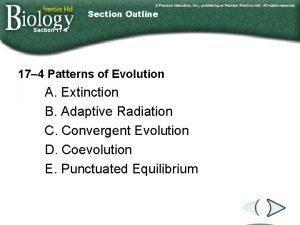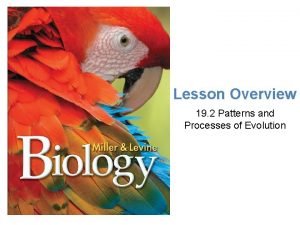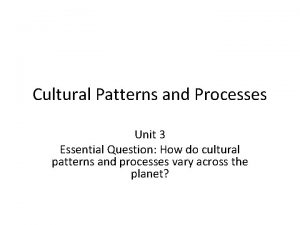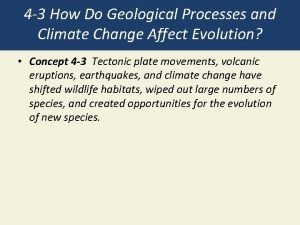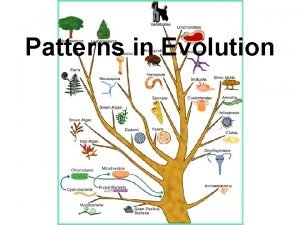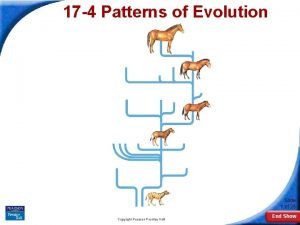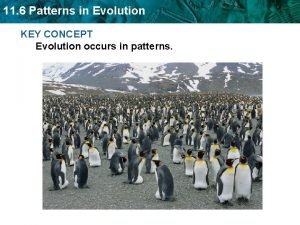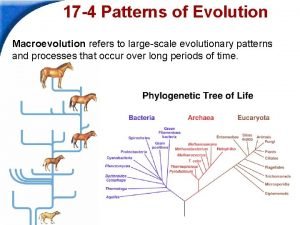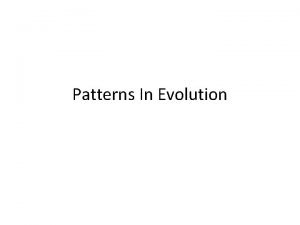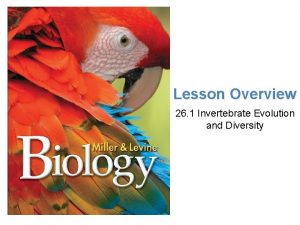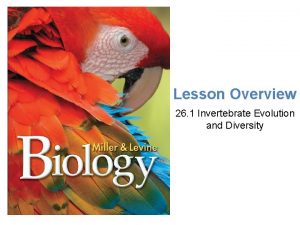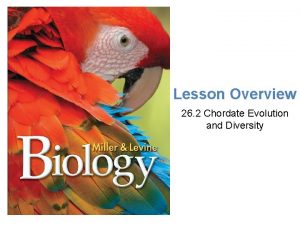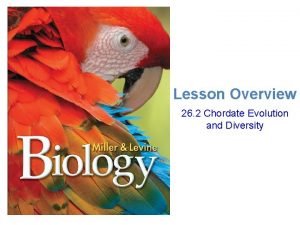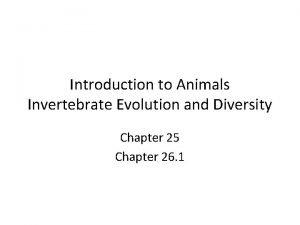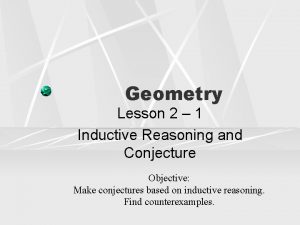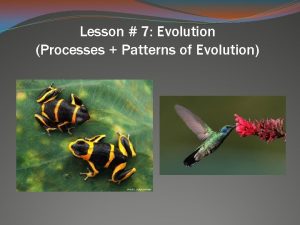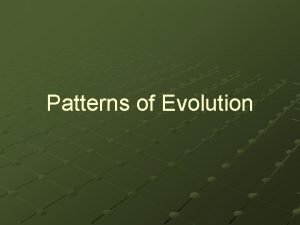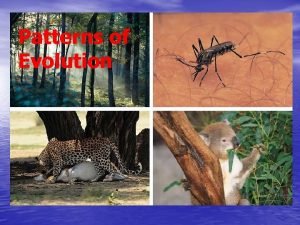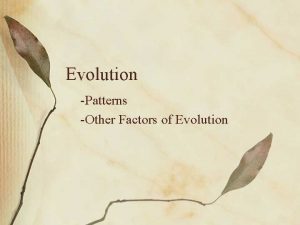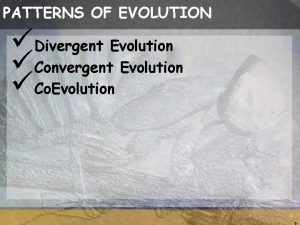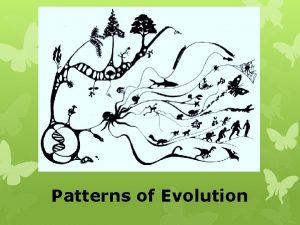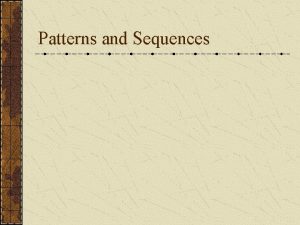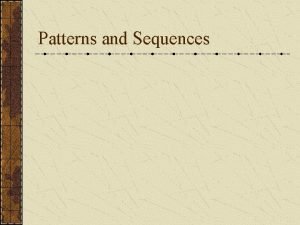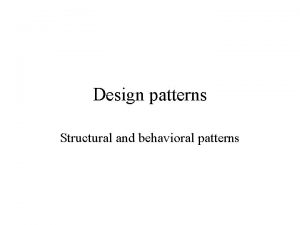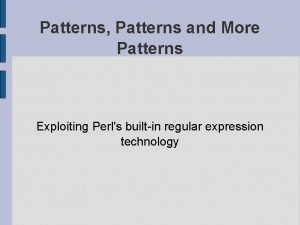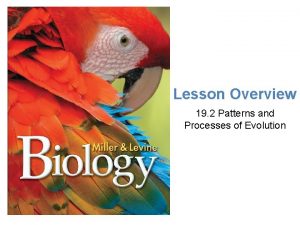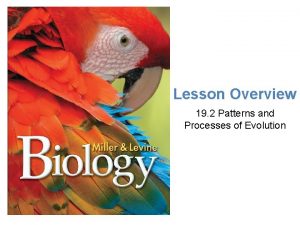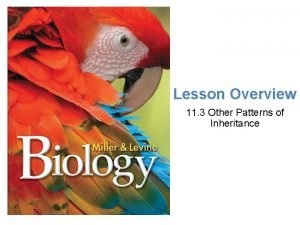Lesson Overview Patterns and Processes of Evolution Types
























- Slides: 24

Lesson Overview Patterns and Processes of Evolution Types & Rates of Evolution

Lesson Overview Patterns and Processes of Evolution Types of Evolution: • • • Microevolution Macroevolution Adaptive Radiation- Divergent Evolution Convergent Evolution Coevolution

Lesson Overview Patterns and Processes of Evolution Microevolution • Microevolution is evolution on a small scale — within a single population. • Biologists who study evolution at this level define microevolution as a change in gene frequency within a population. • Mutation, migration, genetic drift, and natural selection are all processes that can directly affect gene frequencies in a population. • http: //evolution. berkeley. edu/evolibrary/article/_0_0/evo_toc_01 (Rt. Click Open Hyperlink)

Lesson Overview Patterns and Processes of Evolution Macroevolution: 1. All of the changes and diversifications that have happened over the course of life's history. 2. All speciation and extinction. 3. Macroevolutionary patterns are generally what we see when we look at the largescale history of life. http: //evolution. berkeley. edu/evolibrary/article/_0_0/evo_48 (Rt. Click Open Hyperlink)

Lesson Overview Patterns and Processes of Evolution • A clade shows a group of species and their 1 common ancestor. • Phylogeny- is the study of the relationships between living & extinct species.

Lesson Overview Patterns and Processes of Evolution Speciation and Extinction What processes influence whether a species survives or become extinct? Survival – birth rate exceeds death rate Extinction- death rate exceeds birth rate

Lesson Overview Patterns and Processes of Evolution Patterns of Extinction Species are always evolving and competing—and some species become extinct because of the slow but steady process of natural selection, referred to as background extinction. In contrast, a mass extinction affects many species over a relatively short period of time.

Lesson Overview Patterns and Processes of Evolution Geologic evidence shows that at the end of the Cretaceous Period, a huge asteroid crashed into Earth and caused global climate change. At about the same time, dinosaurs and many other species became extinct. Many mass extinctions, however, were probably caused by several factors working in combination: volcanic eruptions, moving continents, and changing sea levels, for example.

Lesson Overview Patterns and Processes of Evolution After a mass extinction, biodiversity is dramatically reduced. Extinction offers new opportunities to survivors. As speciation and adaptation produce new species to fill empty niches, biodiversity recovers. This recovery takes a long time— typically between 5 and 10 million years. Some groups of organisms survive a mass extinction, while other groups do not.

Lesson Overview Patterns and Processes of Evolution Rate of Evolution Evidence shows that evolution has often proceeded at different rates for different organisms at different times over the long history of life on Earth.

Lesson Overview Patterns and Processes of Evolution Gradualism involves a slow, steady change in a particular line of descent. The fossil record shows that many organisms have indeed changed gradually over time.

Lesson Overview Patterns and Processes of Evolution Punctuated Equilibrium Punctuated equilibrium is the term used to describe equilibrium that is interrupted by brief periods of more rapid change. The fossil record reveals periods of relatively rapid change in many groups of organisms.

Lesson Overview Patterns and Processes of Evolution Rapid Evolution After Equilibrium Rapid evolution may occur after a small population becomes isolated from the main population. This small population can evolve faster than the larger one because genetic changes spread more quickly among fewer individuals. Rapid evolution may also occur when a small group of organisms migrates to a new environment. That’s what happened with the Galápagos finches.

Lesson Overview Patterns and Processes of Evolution Adaptive Radiation and Convergent Evolution Two important patterns of macroevolution are adaptive radiation and convergent evolution.

Lesson Overview Patterns and Processes of Evolution Adaptive Radiation Studies often show that a single species or a small group of species has diversified over time into a clade containing many species. These species display variations on the group’s ancestral body plan. They often occupy different ecological niches. Adaptive radiation, an evolutionary process by which a single species or a small group of species evolves over a relatively short time into several different forms that live in different ways.

Lesson Overview Patterns and Processes of Evolution This diagram shows part of the adaptive radiation of mammals.

Lesson Overview Patterns and Processes of Evolution Adaptive Radiation An adaptive radiation may occur when species migrate to a new environment or when extinction clears an environment of a large number of inhabitants. A species may also evolve a new feature that enables it to take advantage of a previously unused environment.

Lesson Overview Patterns and Processes of Evolution Modern Adaptive Radiations Both Galápagos finches and Hawaiian honeycreepers evolved from a single bird species. Both finches and honeycreepers evolved different beaks and different behaviors that enable each of them to eat different kinds of food.

Lesson Overview Patterns and Processes of Evolution Convergent Evolution Sometimes groups of organisms evolve in different places or at different times, but in similar environments. These organisms start out with different structures, but they face similar selection pressures. In these situations, natural selection may mold different body structures in ways that perform similar functions. Because they perform similar functions, these body structures may look similar. Evolution produces similar structures and characteristics in distantly-related organisms through the process of convergent evolution.

Lesson Overview Patterns and Processes of Evolution Convergent Evolution For example, mammals that feed on ants and termites evolved five times in five different regions as shown in the figure below. They all developed the powerful front claws, long hairless snout, and tongue covered with sticky saliva that are necessary adaptations for hunting and eating insects.

Lesson Overview Patterns and Processes of Evolution Coevolution The process by which two species evolve in response to changes in each other over time is called coevolution.

Lesson Overview Patterns and Processes of Evolution Flowers and Pollinators Coevolution of flowers and pollinators is common and can lead to unusual results. For example, Darwin discovered an orchid whose flowers had a 40 -centimeter-long structure called a spur with a supply of nectar at the bottom. Darwin predicted that some pollinating insect must have some kind of feeding structure that would allow it to reach the nectar. Darwin never saw that insect. About 40 years later, researchers discovered a moth with a 40 -centimeter-long feeding tube that matched Darwin’s prediction.

Lesson Overview Patterns and Processes of Evolution Plants and Herbivorous Insects Plants and herbivorous insects also demonstrate close coevolutionary relationships. Over time, many plants have evolved bad-tasting or poisonous compounds that discourage insects from eating them.

Lesson Overview Patterns and Processes of Evolution Plants and Herbivorous Insects Once plants began to produce poisons, natural selection on herbivorous insects favored any variants that could alter, inactivate, or eliminate those poisons. Milkweed plants, for example, produce toxic chemicals. But monarch caterpillars not only can tolerate this toxin, they also can store it in their body tissues to use as a defense against their predators.
 Lesson 17: patterns and processes of evolution
Lesson 17: patterns and processes of evolution Patterns of evolution
Patterns of evolution Lesson 17 patterns and processes of evolution
Lesson 17 patterns and processes of evolution Concurrent processes are processes that
Concurrent processes are processes that Cultural patterns and processes
Cultural patterns and processes How do geological processes affect evolution
How do geological processes affect evolution Behavior patterns or mental processes that interfere
Behavior patterns or mental processes that interfere Eclat algorithm
Eclat algorithm Divergent wvolution
Divergent wvolution 17-4 patterns of evolution
17-4 patterns of evolution Section 6 patterns in evolution
Section 6 patterns in evolution Section 17-4 patterns of evolution answer key
Section 17-4 patterns of evolution answer key What are the two major patterns of evolution?
What are the two major patterns of evolution? Section 17-4 patterns of evolution
Section 17-4 patterns of evolution Dating patterns since the 1960s are
Dating patterns since the 1960s are Structure and evolution of the universe. lesson 1
Structure and evolution of the universe. lesson 1 Invertebrate evolution and diversity
Invertebrate evolution and diversity Invertebrate cladogram
Invertebrate cladogram Diversity of chordates
Diversity of chordates Cladogram of chordates
Cladogram of chordates Snail phylum
Snail phylum Chapter 9 lesson 2 photosynthesis an overview
Chapter 9 lesson 2 photosynthesis an overview Lesson overview
Lesson overview Lesson 1-4 inductive reasoning answers
Lesson 1-4 inductive reasoning answers Geometry lesson 2-1 answers
Geometry lesson 2-1 answers
